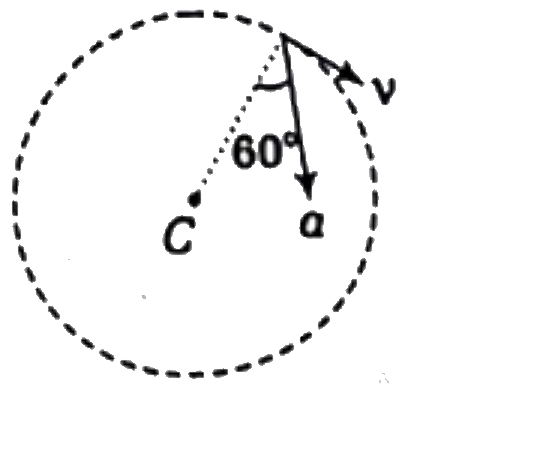A particle of mass m describes a circle of radius r . The centripetal acceleration of the particle is 4r2 . What will be the momentum of the particle ?
2mr
2m√r
4m√r
None of these
The correct Answer is:B
To solve the problem step by step, we will follow these instructions:
Step 1: Write down the given values
We have:
- Mass of the particle, m
- Radius of the circle, r
- Centripetal acceleration, ac=4r2
Step 2: Recall the formula for centripetal acceleration
The formula for centripetal acceleration ac is given by:
ac=v2r
where v is the linear velocity of the particle.
Step 3: Substitute the given centripetal acceleration into the formula
We can substitute the given value of centripetal acceleration into the formula:
4r2=v2r
Step 4: Rearrange the equation to solve for v2
Multiplying both sides by r gives:
4r2⋅r=v2
This simplifies to:
4r=v2
Step 5: Solve for v
Taking the square root of both sides, we find:
v=√4r=2√r
Step 6: Calculate the momentum
The momentum p of the particle is given by the formula:
p=mv
Substituting the value of v we found:
p=m⋅2√r=2m√r
Final Answer
Thus, the momentum of the particle is:
p=2m√r
---
We have:
- Mass of the particle, m
- Radius of the circle, r
- Centripetal acceleration, ac=4r2
The formula for centripetal acceleration ac is given by:
ac=v2r
where v is the linear velocity of the particle.
We can substitute the given value of centripetal acceleration into the formula:
4r2=v2r
Multiplying both sides by r gives:
4r2⋅r=v2
This simplifies to:
4r=v2
Taking the square root of both sides, we find:
v=√4r=2√r
The momentum p of the particle is given by the formula:
p=mv
Substituting the value of v we found:
p=m⋅2√r=2m√r
Thus, the momentum of the particle is:
p=2m√r
Topper's Solved these Questions
- CIRCULAR MOTIONBOOK - DC PANDEY ENGLISHCHAPTER - CIRCULAR MOTIONEXERCISE - Level 2 More Than One Correct
5 Videos
- CIRCULAR MOTIONBOOK - DC PANDEY ENGLISHCHAPTER - CIRCULAR MOTIONEXERCISE - Level 2 Comprehension Based
5 Videos
- CIRCULAR MOTIONBOOK - DC PANDEY ENGLISHCHAPTER - CIRCULAR MOTIONEXERCISE - Level 1 Subjective
13 Videos
- CENTRE OF MASS, LINEAR MOMENTUM AND COLLISIONBOOK - DC PANDEY ENGLISHCHAPTER - CENTRE OF MASS, LINEAR MOMENTUM AND COLLISIONEXERCISE - Level 2 Subjective
21 Videos
- COMMUNICATION SYSTEMBOOK - DC PANDEY ENGLISHCHAPTER - COMMUNICATION SYSTEMEXERCISE - Only One Option is Correct
27 Videos
Similar Questions
Knowledge Check
A particle of mass m is moving in a horizontal circle of radius r, under a centripetal force equal to (−K/r2), where k is a constant. The total energy of the particle is -
A−krB−k2rCk2rD2kr
Centripetal acceleration of a particle of mass m moving in a circle of radius r is 4/r2. What is the angular momentum of the particle ?
View SolutionA particle of mass m is revolving in a horizontal circle of radius r under a centripetal force k/r2 where k is a constant. What is the total energy of the particle ?
View SolutionThe figure shows the total acceleration a=32ms−2 of a moving particle moving clockwise in a circle of radius R = 1 m . What are the centripetal acceleration a and speed of the particle at the given instant ?

View SolutionIf a particle moves in a circle of radius of 4m at speed given by v=2t where v is in m/s and t in sec.At t=4s ,net accleration of particle will be:
View SolutionA particle of mass m is moving in a horizontal circle of radius R under a centripetal force equal to −Ar2 (A = constant). The total energy of the particle is :-
(Potential energy at very large distance is zero)
View SolutionA particle moves in a circle of radius 25 cm at 2 revolution per second. The acceleration of the particle in meter per second2 is
View SolutionIf a particle of mass m is moving in a horizontal circle of radius r with a centripetal force (−1/r2) , the total energy is
View Solution
